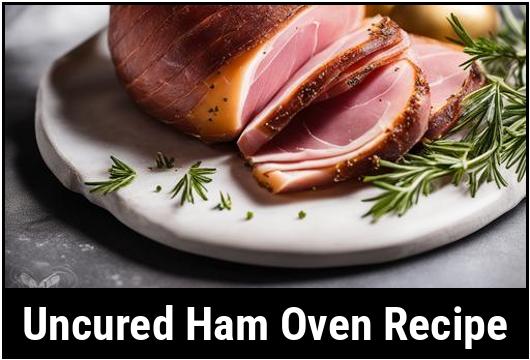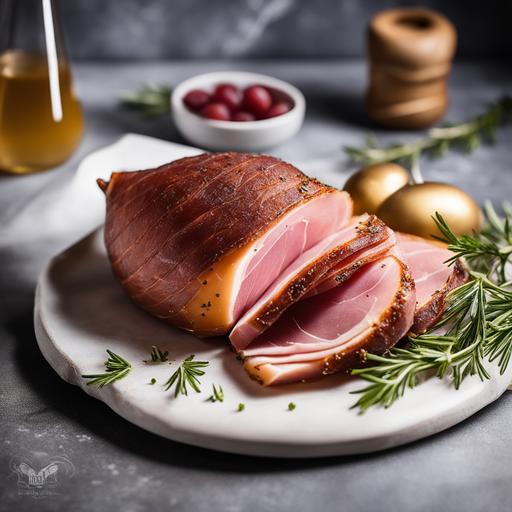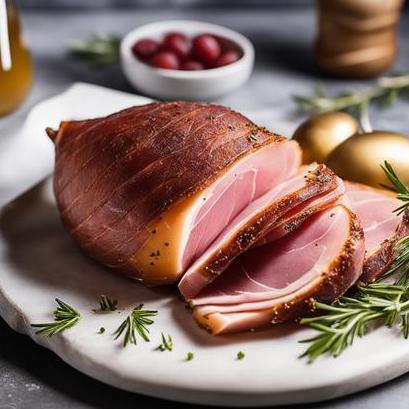
Uncured Ham Oven Recipe: A Delicious And Healthy Option
When it comes to preparing a mouthwatering and healthy ham dish, an uncured ham oven recipe is an excellent choice. Unlike cured ham, which undergoes a lengthy and often unhealthy preservation process, uncured ham offers a fresh and natural alternative. In this comprehensive guide, we will delve into the fascinating world of uncured ham, exploring its food science, culinary details, selection, cleaning, preparation, tips, variations, doneness checks, and finally, the recipe that will leave your taste buds craving for more. So let’s dive right in!
Understanding the Food Science Behind Uncured Ham
Uncured ham is a raw cut of pork that has not gone through the curing process, which means it hasn’t been treated with curing salts or nitrates. Instead, uncured ham is typically flavored with a variety of natural spices, such as garlic, pepper, and paprika, to enhance its taste and preserve it.
The absence of curing agents in uncured ham makes it a healthier option since it reduces the risks associated with consuming excessive amounts of sodium and nitrates. Furthermore, the omission of these additives allows the natural flavors of the pork to shine through, resulting in a more authentic and delicious eating experience.
Selecting the Perfect Uncured Ham
When it comes to choosing the best uncured ham for your oven recipe, several factors should be considered. Here’s what you need to keep in mind:
-
Quality: Look for a fresh and high-quality uncured ham that is free from any blemishes or discoloration. Opting for organic or pasture-raised pork can enhance the flavor and overall quality of your dish.
-
Weight: Consider the size of the ham depending on the number of servings you plan to prepare. As a rule of thumb, estimate about 1/2 pound of ham per person.
-
Bone-In or Boneless: Decide whether you prefer a bone-in ham, which tends to yield juicier meat, or a boneless ham, which allows for easier slicing.
-
Fat Content: Look for a well-marbled ham, as the fat content contributes to a juicier and more flavorsome end result.
Cleaning and Preparing the Uncured Ham

Before cooking your uncured ham in the oven, it is crucial to clean and prepare it properly. Here’s a step-by-step guide to help you:
-
Rinse the Ham: Rinse the uncured ham under cold running water to remove any surface impurities. Pat it dry with paper towels afterward.
-
Trim Excess Fat: While fat adds flavor, it’s important to trim any excess fat from the ham’s surface, as it can become greasy during cooking.
-
Score the Skin: Use a sharp knife to create shallow score marks on the ham’s skin, forming a diamond pattern. This helps the flavors penetrate the meat and gives the finished dish a beautiful presentation.
Tips for Cooking the Perfect Uncured Ham in the Oven
To ensure your uncured ham turns out succulent and flavorful, consider the following tips:
-
Brining: For an extra layer of flavor and juiciness, consider brining your uncured ham prior to cooking. Prepare a solution of water, salt, and your preferred aromatics (such as bay leaves, cloves, or rosemary), and immerse the ham in it for several hours or overnight.
-
Preheating the Oven: Preheat your oven to 325°F (163°C) to allow for even cooking and to retain the ham’s moisture.
-
Cooking Time: Plan for approximately 20 minutes of cooking time per pound of uncured ham. Using a meat thermometer, you can monitor its internal temperature and ensure it reaches 145°F (63°C) for safe consumption.
Variations and Flavor Enhancements

While the delicious flavors of uncured ham are often enough to satisfy any palate, you can also experiment with various additions and glazes to elevate your dish. Here are a few ideas to get you started:
-
Fresh Herb Rub: Create a flavorful herb mixture using your favorite herbs, such as thyme, rosemary, and sage. Rub this mixture onto the ham before cooking for an aromatic treat.
-
Sweet and Tangy Glaze: For a delightful balance of flavors, prepare a glaze using ingredients like honey, Dijon mustard, and apple cider vinegar. Brush this glaze onto the ham during the last half hour of cooking for a caramelized and glossy finish.
-
Fruit Accompaniments: Serve slices of uncured ham with pineapple or mango chutney for a tropical twist, or pair it with roasted apples or pears for a delightful combination of sweet and savory.
Checking for Doneness and Resting the Uncured Ham
Properly checking the doneness of your uncured ham ensures it is cooked to perfection without being underdone or overcooked. Here’s what you need to do:
-
Internal Temperature: Insert a meat thermometer into the thickest part of the ham without touching the bone. Once it reads 145°F (63°C), your uncured ham is ready to be taken out of the oven.
-
Resting Period: After removing the ham from the oven, tent it loosely with aluminum foil and let it rest for approximately 15-20 minutes. This allows the juices to redistribute evenly throughout the meat, resulting in a moist and tender final product.
The Ultimate Uncured Ham Oven Recipe
Finally, here’s an easy and flavorful recipe that will make your uncured ham the star of any gathering:
Ingredients:
-
1 uncured ham (5 pounds)
-
1 cup brown sugar
-
1/4 cup Dijon mustard
-
2 tablespoons apple cider vinegar
-
1 teaspoon ground black pepper
-
1/2 teaspoon ground cloves
Instructions:
-
Preheat your oven to 325°F (163°C).
-
In a small bowl, combine the brown sugar, Dijon mustard, apple cider vinegar, black pepper, and ground cloves.
-
Place the uncured ham on a rack inside a roasting pan, fat side up. Brush the glaze generously over the ham, ensuring the entire surface is coated.
-
Insert a meat thermometer into the thickest part of the ham, being careful not to touch the bone.
-
Place the roasting pan in the preheated oven and bake for approximately 20 minutes per pound, or until the internal temperature of the ham reaches 145°F (63°C) on the thermometer.
-
Once cooked, remove the ham from the oven and tent it loosely with aluminum foil. Allow it to rest for 15-20 minutes.
-
Slice the uncured ham and serve it alongside your favorite sides and accompaniments.
With this fabulous uncured ham oven recipe, you are guaranteed to wow your guests and create lasting memories around the dining table.
Enjoy the simplicity and wholesome flavors of uncured ham, knowing that you have prepared a delicious and healthy dish that your family and friends will love. Bon appétit!
Sources
FAQS On Uncured Ham Oven Recipe
What Is An Uncured Ham?
An uncured ham is a type of ham that has not been preserved or treated with any curing agents such as salt, nitrates, or nitrites. This results in a more natural and less salty flavor compared to cured hams.
Can I Bake An Uncured Ham In The Oven?
Yes, you can bake an uncured ham in the oven by following a specific recipe and cooking instructions. It is important to note that uncured ham may require a longer cooking time compared to cured hams as it has not been pre-processed to be ready-to-eat.
How Do I Prepare An Uncured Ham For Baking?
Before baking, it is recommended to rinse the uncured ham under cold water and pat it dry. You can also score the outside of the ham with a knife to allow for more even cooking and flavor absorption. Optional glazes or seasonings can also be applied before baking.
How Long Does An Uncured Ham Need To Bake In The Oven?
The baking time for an uncured ham depends on the weight and type of ham. As a general rule, an uncured whole ham should be baked for approximately 22 minutes per pound at 325 degrees Fahrenheit. It is important to use a meat thermometer to ensure the internal temperature reaches at least 145 degrees Fahrenheit.
Can I Use The Oven To Cook Other Dishes While An Uncured Ham Is Baking?
Yes, it is possible to use the oven for other dishes while the uncured ham is baking. However, it is important to ensure that the oven temperature and cooking time for the other dishes do not interfere with the ham’s cooking process. It is also recommended to place the ham on a lower rack to prevent any drippings from falling onto other dishes.


